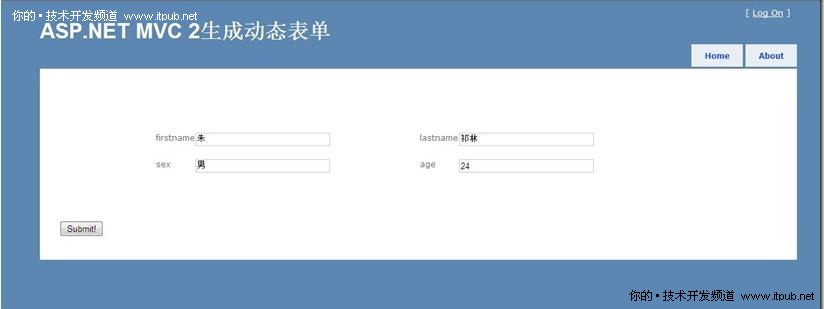【IT168 技术开发】在BPM、OA等系统中,都会存在一个表单设计器。有些是通过操作gridview来完成一个表单的设计;有些是通过类似VS拖拽的方法完成一个表单的设计。很明显后面一种优越于前面一种。无论是哪种,最后都会产生一些XML之类的表单结构的数据。
这篇文章将讲述,在表单设计器设计好表单之后,在ASP.NET MVC中如何将表单结构的xml转换成实际应用系统中的表单。看下面一个xml文件,我们假设它是由一个表单设计器设计出来的。
<?xml version="1.0" encoding="utf-8" ?>
<form name="form1">
<field type="text" name ="firstname" class ="textbox" left="300" top="200">朱</field>
<field type="text" name ="lastname" class ="textbox" left="700" top="200">祁林</field>
<field type="text" name ="sex" class ="textbox" left="300" top="240">男</field>
<field type="text" name ="age" class ="textbox" left="700" top="240">24</field>
</form>
<form name="form1">
<field type="text" name ="firstname" class ="textbox" left="300" top="200">朱</field>
<field type="text" name ="lastname" class ="textbox" left="700" top="200">祁林</field>
<field type="text" name ="sex" class ="textbox" left="300" top="240">男</field>
<field type="text" name ="age" class ="textbox" left="700" top="240">24</field>
</form>
下面,我将把它转化成实际的asp.net mvc系统中的表单。首先,使用LinqtoXML将上面的XML文件转换成XElement,代码如下。在控制器中最好不要直接读取文件,这里为了简单直观起见,就直接在Controller中读取xml文件了。
[AcceptVerbs(HttpVerbs.Get)]
public ActionResult Index()
{
XElement xml = XElement.Load(Server.MapPath("~/App_Data/form1.xml"));
ViewData["xml"] = xml;
return View();
}
public ActionResult Index()
{
XElement xml = XElement.Load(Server.MapPath("~/App_Data/form1.xml"));
ViewData["xml"] = xml;
return View();
}
接着我们将在View中,将上面的XElement转换成真正的HTML表单。 在表单设计器中很难的一块就是控件的定位。从我提供的XML中可以看到,它里面是存放了位置信息的。这使我们想到了div的绝对布局。这个方法在这种情况下非常的适合。
下面,我定义两个字符串模板:
string label = " <div style=\"left: {0}px; position: absolute; top: {1}px\">{2}</div>";
string input = "<input name=\"{0}\" type=\"{1}\" class=\"{2}\" style=\"left: {3}px; position: absolute; top:
string input = "<input name=\"{0}\" type=\"{1}\" class=\"{2}\" style=\"left: {3}px; position: absolute; top:
label用于显示文本信息,input用于显示表单上的value。下面通过循环产生html脚本。
StringBuilder sb = new StringBuilder();
sb.Append(" <div style=\"height:200px\"> ");
foreach(XElement f in xml.Elements())
{
sb.Append(string.Format(label, int.Parse(f.Attribute("left").Value) - 60, f.Attribute("top").Value, f.Attribute("name").Value));
sb.Append(string.Format(input, f.Attribute("name").Value, f.Attribute("type").Value, f.Attribute("class").Value, f.Attribute("left").Value, f.Attribute("top").Value, f.Value));
}
sb.Append("</div > ");
sb.Append(" <div style=\"height:200px\"> ");
foreach(XElement f in xml.Elements())
{
sb.Append(string.Format(label, int.Parse(f.Attribute("left").Value) - 60, f.Attribute("top").Value, f.Attribute("name").Value));
sb.Append(string.Format(input, f.Attribute("name").Value, f.Attribute("type").Value, f.Attribute("class").Value, f.Attribute("left").Value, f.Attribute("top").Value, f.Value));
}
sb.Append("</div > ");
最后通过Response.Write(sb.ToString())输出。
整个View的代码如下:
<%@ Page Language="C#" MasterPageFile="~/Views/Shared/Site.Master" Inherits="System.Web.Mvc.ViewPage" %>
<asp:Content ID="Content1" ContentPlaceHolderID="TitleContent" runat="server">
Home Page
</asp:Content>
<asp:Content ID="Content2" ContentPlaceHolderID="MainContent" runat="server">
<% XElement xml = (XElement)ViewData["xml"]; %>
<%Html.BeginForm(); %> <%
string label = " <div style=\"left: {0}px; position: absolute; top: {1}px\">{2}</div>";
string input = "<input name=\"{0}\" type=\"{1}\" class=\"{2}\" style=\"left: {3}px; position: absolute; top: {4}px\" value=\"{5}\" />";
StringBuilder sb = new StringBuilder();
sb.Append(" <div style=\"height:200px\"> ");
foreach(XElement f in xml.Elements())
{
sb.Append(string.Format(label, int.Parse(f.Attribute("left").Value) - 60, f.Attribute("top").Value, f.Attribute("name").Value));
sb.Append(string.Format(input, f.Attribute("name").Value, f.Attribute("type").Value, f.Attribute("class").Value, f.Attribute("left").Value, f.Attribute("top").Value, f.Value));
}
sb.Append("</div > ");
Response.Write(sb.ToString());
%>
<input type="submit" value="Submit!" />
<%Html.EndForm(); %>
</asp:Content>
<asp:Content ID="Content1" ContentPlaceHolderID="TitleContent" runat="server">
Home Page
</asp:Content>
<asp:Content ID="Content2" ContentPlaceHolderID="MainContent" runat="server">
<% XElement xml = (XElement)ViewData["xml"]; %>
<%Html.BeginForm(); %> <%
string label = " <div style=\"left: {0}px; position: absolute; top: {1}px\">{2}</div>";
string input = "<input name=\"{0}\" type=\"{1}\" class=\"{2}\" style=\"left: {3}px; position: absolute; top: {4}px\" value=\"{5}\" />";
StringBuilder sb = new StringBuilder();
sb.Append(" <div style=\"height:200px\"> ");
foreach(XElement f in xml.Elements())
{
sb.Append(string.Format(label, int.Parse(f.Attribute("left").Value) - 60, f.Attribute("top").Value, f.Attribute("name").Value));
sb.Append(string.Format(input, f.Attribute("name").Value, f.Attribute("type").Value, f.Attribute("class").Value, f.Attribute("left").Value, f.Attribute("top").Value, f.Value));
}
sb.Append("</div > ");
Response.Write(sb.ToString());
%>
<input type="submit" value="Submit!" />
<%Html.EndForm(); %>
</asp:Content>
效果:
1、显示XML表单:

2、提交表单:

总结:这个是一种通过表单设计器产生动态表单最简单的方式。也是非常通用的一种方式。在产生html的时候,你可以带上Jquery的验证的脚本。当然还有很多的扩展和完善。


